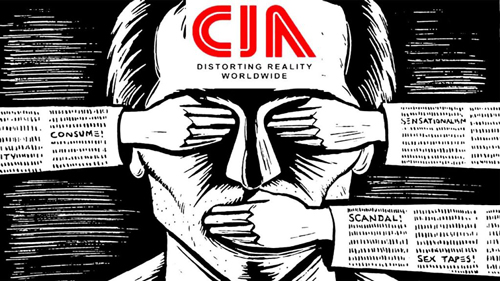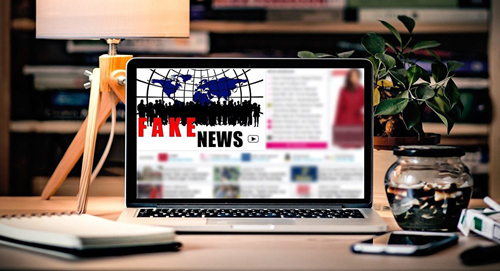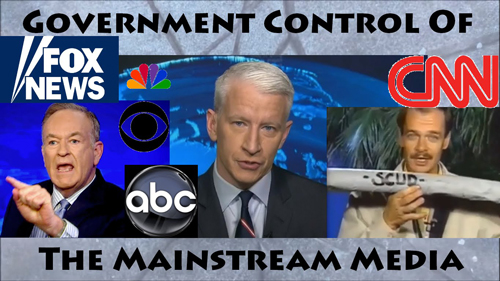50 Facts The World Needs To Know About Mainstream Media’s Relationship With The US Government (1)
James F. Tracy is a PhD from the University of Iowa. A former professor of communications at Boca Raton, Florida Atlantic University. He is one of many critical thinkers within the world of academia, and as result of presenting the following information that might spark some cognitive dissonance, he has been singled out due to his activism efforts. For example, he was fired from his tenured professorship at Florida Atlantic University for questioning official narratives of terror events. Even his Blog has been taken down by WordPress with no clear explanation. He made national headlines, as many academics who are not afraid to stand up for truth do, in an attempt to ridicule them. He is well researched, and reports on several different matters of escalating importance.
Below is an article he wrote in August of 2015, and is relevant today given all of the “fake news” campaigns that have been directed against alternative media.

Since the end of World War Two the Central Intelligence Agency has been a major force in US and foreign news media, exerting considerable influence over what the public sees, hears and reads on a regular basis. CIA publicists and journalists alike will assert they have few, if any, relationships, yet the seldom acknowledged history of their intimate collaboration indicates a far different story–indeed, one that media historians are reluctant to examine.
When seriously practiced, the journalistic profession involves gathering information concerning individuals, locales, events, and issues. In theory such information informs people about their world, thereby strengthening “democracy.” This is exactly the reason why news organizations and individual journalists are tapped as assets by intelligence agencies and, as the experiences of German journalist Udo Ulfkotte suggest, this practice is at least as widespread today as it was at the height of the Cold War.
Consider the coverups of election fraud in 2000 and 2004, the events of September 11, 2001, the invasions Afghanistan and Iraq, the destabilization of Syria, and the creation of “ISIS.” These are among the most significant events in recent world history, and yet they are also those much of the American public is wholly ignorant of. In an era where information and communication technologies are ubiquitous, prompting many to harbor the illusion of being well-informed, one must ask why this condition persists.
Further, why do prominent US journalists routinely fail to question other deep events that shape America’s tragic history over the past half century, such as the political assassinations of the 1960s, or the central role played by the CIA major role in international drug trafficking?
Popular and academic commentators have suggested various reasons for the almost universal failure of mainstream journalism in these areas, including newsroom sociology, advertising pressure, monopoly ownership, news organizations’ heavy reliance on “official” sources, and journalists’ simple quest for career advancement. There is also, no doubt, the influence of professional public relations maneuvers. Yet such a broad conspiracy of silence suggests another province of deception examined far too infrequently – specifically the CIA and similar intelligence agencies’ continued involvement in the news media to mold thought and opinion in ways scarcely imagined by the lay public.
The following historical and contemporary facts, by no means exhaustive, provides a glimpse of how the power such entities possess to influence if not determine popular memory and what respectable institutions deem to be the historical record.
1. The CIA’s Operation MOCKINGBIRD is a long-recognised keystone among researchers pointing to the Agency’s clear interest in and relationship to major US news media. MOCKINGBIRD grew out of the CIA’s forerunner, the Office for Strategic Services (OSS, 1942-47), which during World War Two had established a network of journalists and psychological warfare experts operating primarily in the European theatre.
2. Many of the relationships forged under OSS auspices were carried over into the postwar era through a State Department-run organization called the Office of Policy Coordination (OPC) overseen by OSS staffer Frank Wisner.
3. The OPC “became the fastest-growing unit within the nascent CIA,” historian Lisa Pease observed, “rising in personnel from 302 in 1949 to 2,812 in 1952, along with 3,142 overseas contract personnel. In the same period, the budget rose from $4.7 million to $82 million.” Lisa Pease, The Media and the Assassination, in James DiEugenio and Lisa Pease, The Assassinations: Probe Magazine on JFK, MLK, RFK and Malcolm X, Port Townsend, WA, 2003, 300.
4. Like many career CIA officers, eventual CIA Director/Director of Central Intelligence (DCI) Richard Helms was recruited out of the press corps by his own supervisor at the United Press International’s Berlin Bureau to join in the OSS’s fledgling “black propaganda” program. “You’re a natural,” Helms’ boss remarked. Richard Helms, A Look Over My Shoulder: A Life in the Central Intelligence Agency, New York: Random House, 2003, 30-31.
5. Wisner tapped Marshall Plan funds to pay for his division’s early exploits, money his branch referred to as ‘candy’. “We couldn’t spend it all,” CIA agent Gilbert Greenway recalls. “I remember once meeting with Wisner and the comptroller. My God, I said, how can we spend that? There were no limits, and nobody had to account for it. It was amazing.” Frances Stonor Saunders, The Cultural Cold War: The CIA and the World of Arts and Letters, New York: The New Press, 2000, 105.
6. When the OPC was merged with the Office of Special Operations in 1948 to create the CIA, OPC’s media assets were likewise absorbed.
7. Wisner maintained the top secret Propaganda Assets Inventory, better known as Wisner’s Wurlitzer – a virtual rolodex of over 800 news and information entities prepared to play whatever tune Wisner chose. “The network included journalists, columnists, book publishers, editors, entire organizations such as Radio Free Europe, and stringers across multiple news organizations.” Pease, The Media and the Assassination, 300.

8. A few years after Wisner’s operation was up-and-running he ‘owned’ respected members of the New York Times, Newsweek, CBS, and other communication vehicles, plus stringers, four to six hundred in all, according to a CIA analyst. Each one was a separate ‘operation,’ investigative journalist Deborah Davis notes, “requiring a code name, a field supervisor, and a field office, at an annual cost of tens or hundreds of thousands of dollars – there has never been an accurate accounting.” Deborah Davis, Katharine the Great: Katharine Graham and the Washington Post, Second Edition, Bethesda MD: National Press Inc, 1987, 139.
9. Psychological operations in the form of journalism were perceived as necessary to influence and direct mass opinion, as well as elite perspectives. “The President of the United States, the Secretary of State, Congressmen and even the Director of the CIA himself will read, believe, and be impressed by a report from Cy Sulzberger, Arnaud de Borchgrave, or Stewart Alsop when they don’t even bother to read a CIA report on the same subject,” noted CIA agent Miles Copeland. Cited in Pease, The Media and the Assassination, 301.
10. By the mid-to-late 1950s, Darrell Garwood points out, the Agency sought to limit criticism directed against covert activity and bypass congressional oversight or potential judicial interference by “infiltrating the groves of academia, the missionary corps, the editorial boards of influential journal and book publishers, and any other quarters where public attitudes could be effectively influenced.” Darrell Garwood, Under Cover: Thirty-Five Years of CIA Deception, New York: Grove Press, 1985, 250.
11. The CIA frequently intercedes in editorial decision-making. For example, when the Agency proceeded to wage an overthrow of the Arbenz regime in Guatemala in 1954, Allen and John Foster Dulles, President Eisenhower’s Secretary of State and CIA Director respectively, called upon New York Times publisher Arthur Hays Sulzberger to reassign reporter Sydney Gruson from Guatemala to Mexico City. Sulzberger thus placed Gruson in Mexico City with the rationale that some repercussions from the revolution might be felt in Mexico. Pease, The Media and the Assassination, 302.
12. Since the early 1950s the CIA “has secretly bankrolled numerous foreign press services, periodicals and newspapers – both English and foreign language – which provided excellent cover for CIA operatives,” Carl Bernstein reported in 1977. “One such publication was the Rome Daily American, forty percent of which was owned by the CIA until the 1970s.” Carl Bernstein, The CIA and the Media, Rolling Stone, October 20, 1977.
13. The CIA exercised informal liaisons with news media executives, in contrast to its relationships with salaried reporters and stringers, “who were much more subject to direction from the Agency” according to Bernstein. “A few executives – Arthur Hays Sulzberger of the New York Times among them – signed secrecy agreements. But such formal understandings were rare: relationships between Agency officials and media executives were usually social – ‘The P and Q Street axis in Georgetown,’ said one source. ‘You don’t tell William Paley to sign a piece of paper saying he won’t fink.’” Director of CBS William Paley’s personal “friendship with CIA Director Dulles is now known to have been one of the most influential and significant in the communications industry,” author Debora Davis explains. “He provided cover for CIA agents, supplied out-takes of news film, permitted the debriefing of reporters, and in many ways set the standard for the cooperation between the CIA and major broadcast companies which lasted until the mid-1970s.” Deborah Davis, Katharine the Great: Katharine Graham and the Washington Post, Second Edition, Bethesda MD: National Press Inc, 1987, 175.

14. “The Agency’s relationship with the Times was by far its most valuable among newspapers, according to CIA officials,” Bernstein points out in his key 1977 article.
“From 1950 to 1966, about ten CIA employees were provided Times cover under arrangements approved by the newspaper’s late publisher, Arthur Hays Sulzberger. The cover arrangements were part of a general Times policy – set by Sulzberger – to provide assistance to the CIA whenever possible.”
In addition, Sulzberger was a close friend of CIA Director Allen Dulles. “‘At that level of contact it was the mighty talking to the mighty’, said a high level CIA official who was present at some of the discussions. ‘There was an agreement in principle that, yes indeed, we would help each other. The question of cover came up on several occasions. It was agreed that the actual arrangements would be handled by subordinates. The mighty didn’t want to know the specifics; they wanted plausible deniability.’” Bernstein, The CIA and the Media.
15.
CBS’s Paley worked reciprocally with the CIA, allowing the Agency to utilize network resources and personnel. “It was a form of assistance that a number of wealthy persons are now generally known to have rendered the CIA through their private interests,” veteran broadcast journalist Daniel Schorr wrote in 1977.
“It suggested to me, however, that a relationship of confidence and trust had existed between him and the agency.” Schorr points to “clues indicating that CBS had been infiltrated.” For example, “A news editor remembered the CIA officer who used to come to the radio control room in New York in the early morning, and, with the permission of persons unknown, listened to CBS correspondents around the world recording their ‘spots’ for the ‘World News Roundup’ and discussing events with the editor on duty. Sam Jaffe claimed that when he applied in 1955 for a job with CBS, a CIA officer told him that he would be hired – which he subsequently was.
He was told that he would be sent to Moscow – which he subsequently was; he was assigned in 1960 to cover the trial of U-2 pilot Francis Gary Powers. Richard Salant told me,” Schorr continues, “that when he first became president of CBS News in 1961, a CIA case officer called saying he wanted to continue the ‘long standing relationship known to Paley and (CBS president Frank) Stanton, but Salant was told by Stanton there was no obligation that he knew of.” Schorr, Daniel. Clearing the Air, Boston: Houghton Mifflin, 1977, 277, 276.
16.
National Enquirer publisher Gene Pope Jr. worked briefly on the CIA’s Italy desk in the early 1950s and maintained close ties with the Agency thereafter. Pope refrained from publishing dozens of stories with “details of CIA kidnappings and murders, enough stuff for a year’s worth of headlines” in order to “collect chits, IOUs,” Pope’s son writes. “He figured he’d never know when he might need them, and those IOUs would come in handy when he got to 20 million circulation. When that happened, he’d have the voice to be almost his own branch of government and would need the cover.” Paul David Pope, The Deeds of My Fathers: How My Grandfather and Father Built New York and Created the Tabloid World of Today, New York: Phillip Turner/Rowman & Littlefield, 2010, 309.
17. One explosive story Pope’s National Enquirer’s refrained from publishing in the late 1970s centered on excerpts from a long-sought after diary of President Kennedy’s lover, Mary Pinchot Meyer, who was murdered on October 12, 1964.
“The reporters who wrote the story were even able to place James Jesus Angleton, the CIA’s head of counterintelligence operations, at the scene.” Another potential story drew on “documents proving that [Howard] Hughes and the CIA had been connected for years and that the CIA was giving Hughes money to secretly fund, with campaign donations, twenty-seven congressmen and senators who sat on sub-committees critical to the agency. There are also fifty-three international companies named and sourced as CIA fronts and even a list of reporters for mainstream media organizations who were playing ball with the agency.” Pope, The Deeds of My Fathers, 309.
Read the second part of the article
yogaesoteric
March 8, 2019
